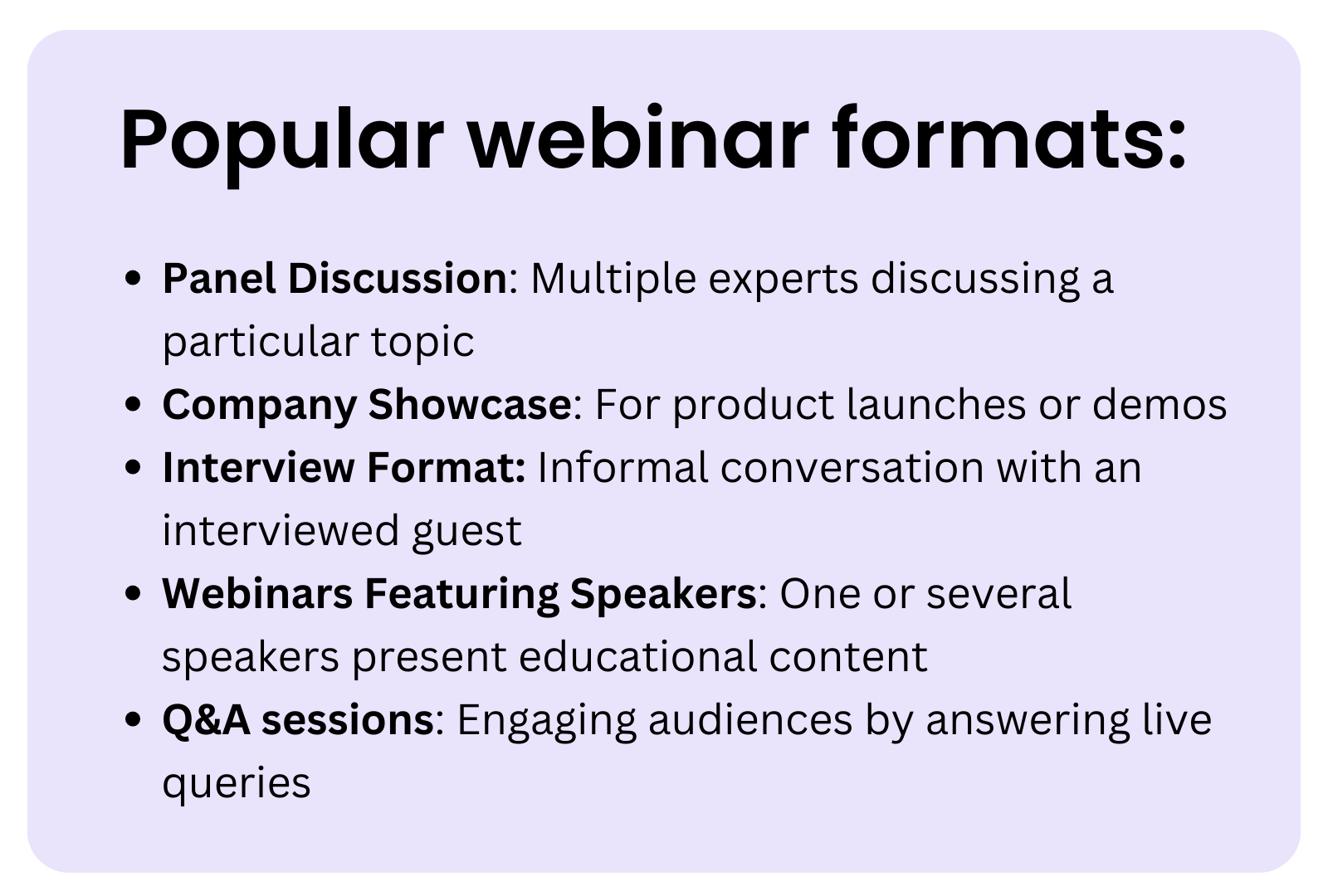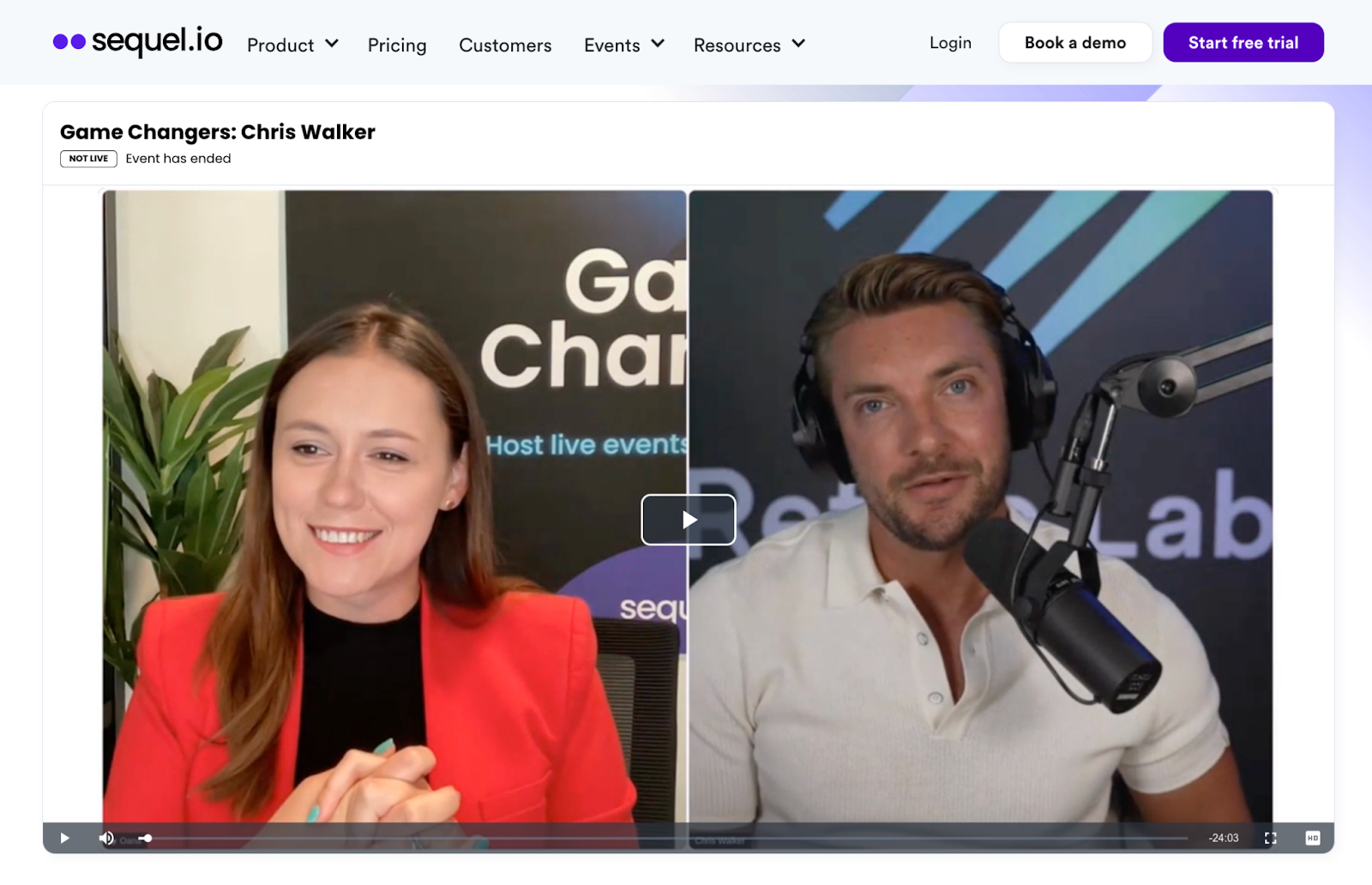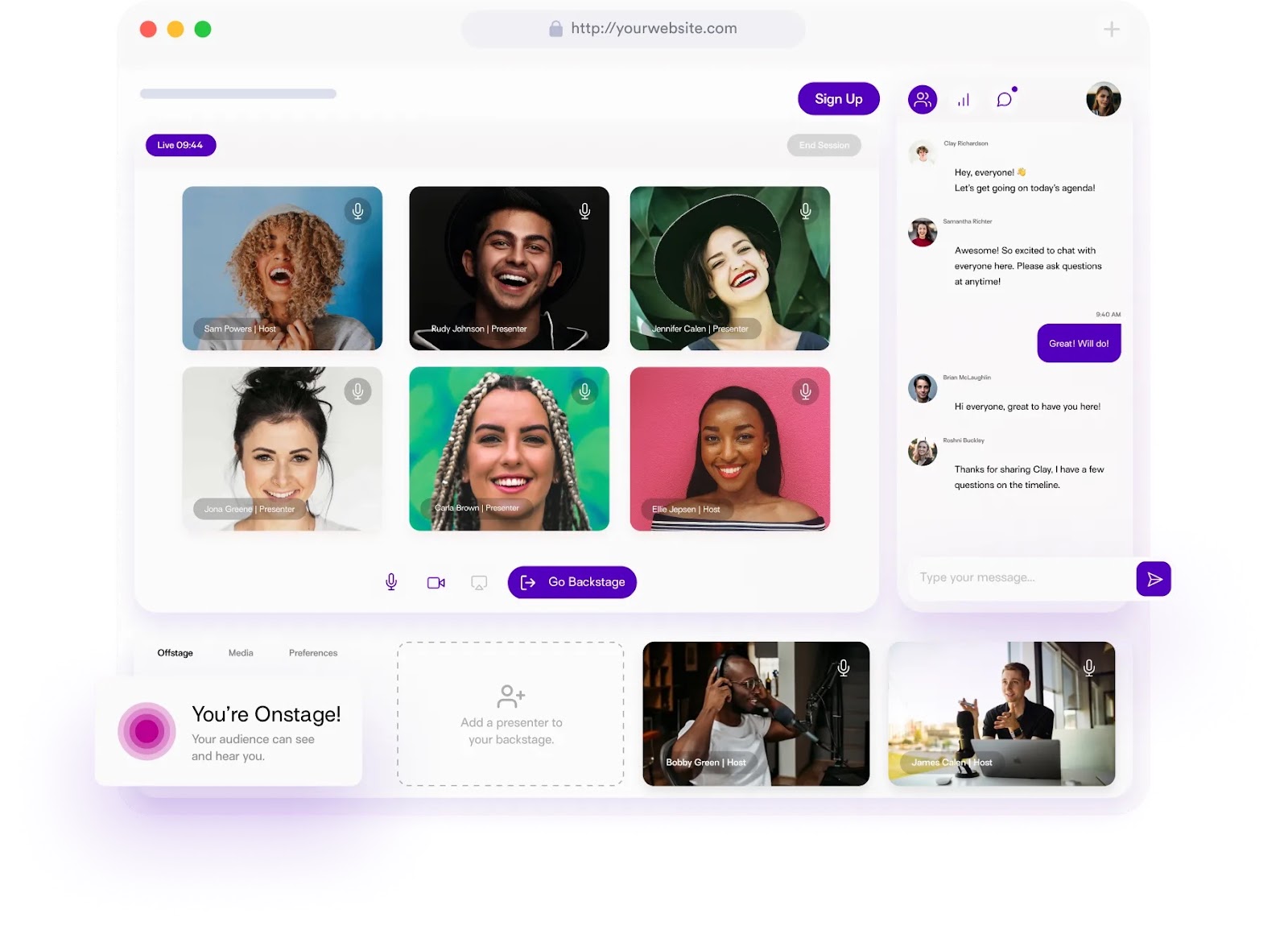How to Decide Which Webinar Format is Right for You
Webinars are a great way to reach a global audience, engage with them in real time, and deliver content that is informative and entertaining. However, with the range of available webinar formats, it can be difficult to know which one is best for your needs. In this blog post, we’ll explore the different types of webinars & their benefits, helping you decide which format will work best for your goals.
We will also cover how to create an engaging user experience for your webinar attendees, the technical requirements, and the costs associated with each format. By the end of this post, you should have all the information needed to select the perfect webinar format for you! Now, let’s dive in!
Exploring different webinar formats
At its core, a webinar is an online event where attendees participate from any device connected to the internet. However, there are various types of webinars available, ranging from Ask Me Anything (AMA) sessions to panel discussions and interviews.
Each webinar type offers different advantages depending on what your goals are for the event. Some even offer more engagement opportunities, while others provide more control over how much time is spent on each topic.

Let’s take a closer look at each type of webinar available:
- Ask Me Anything (AMA) session: An AMA session allows participants to ask questions directly to the presenter or panelists in real time. You can get the audience involved via chat or even put them on stage during the webinar. AMAs provide ample opportunities for audience engagement as well as allow speakers to answer questions quickly without relying solely on pre-scripted material. Compared to a Q&A webinar, an AMA is more focused on thought leadership & industry expertise.
- Panel discussion: A panel discussion involves multiple thought leaders discussing specific topics related to a particular field or industry. This type of webinar allows speakers to share their perspectives while allowing participants to draw their own conclusions.
- Interview: Interviews are just like they sound. They generally involve one speaker asking another person questions about their expertise or experiences related to a given topic. The interviewer or webinar host typically controls the flow of the conversation while the speaker educates the audience using questions as a prompt.
- Speaker presentation: Speaker-centric webinars consist primarily of one subject matter expert educating an audience on a specific topic. They may use a lecture or demo approach or simply go through slideshows and videos. These types of webinars give audiences an in-depth look into a certain topic by providing comprehensive explanations and detailed instructions.
- Company showcase: Company showcases usually involve hosts that are introducing new products, services, technologies, etc. They highlight key features through demonstrations and/or surveys conducted during the event itself. These webinars help attract potential customers who may be interested in your solution while also giving current customers insight into upcoming updates!
- Q&A sessions: Q&A sessions involve attendees asking questions directly related either to specific topics covered during a presentation/lecture or general inquiries about products/services offered by the speaker’s company. They allow audiences an opportunity to learn from questions asked by other attendees and can give companies valuable feedback on specific offerings.
Now that we know what types of webinars are available, let’s explore how each type can benefit you depending on your goals!
Understanding the benefits & drawbacks of each format
Webinar formats come with a variety of benefits depending on the type and purpose of your event. Q&A and Ask Me Anything (AMA) Sessions offer personalized answers to questions from an audience in real-time but require some prep work to collect questions & prepare backup questions in case people are not as active as planned.
Panel Discussions provide varying perspectives on complex topics. The challenge with choosing this format is getting multiple speakers to provide varying viewpoints on one topic while navigating clashing personalities and schedules.
Interviews provide an informal setting for discussing various issues. You may only get one perspective on the topic, but it will be easier to work with your partner to create the content & schedule the webinar. It’s also a great format if you want to provide value in a shorter time.
Speaker Centric sessions allow one presenter full control over the session. The only thing to watch out for here is engagement. If one person is talking the entire time, it can be a bit boring. Try to include interactive bits, random shout-outs, or ask questions so that you can keep your audience’s attention.
Company Showcases promote products/services without the need for multiple presenters. If you choose to use this format, just remember to provide value over all else. Even if you’re talking about your product, you don’t need to be pitching your product so heavily that it drives people away.
Some of the best webinar formats, or at least the most popular & engaging ones, are the interview, panel, and AMA webinar formats. The Game Changers webinar series is a good example of an interview format. Because the structure is fairly simple, the webinars can be hosted on a weekly basis and for only 30 minutes.

Each format has its own advantages and drawbacks that need to be considered to make the right decision for your webinar. With proper preparation, each event can be a success!
Finding the right fit for your needs
Finding the right webinar format for your needs can be a daunting task, but I’m here to help you assess your options.
The first step is to evaluate what your audience cares about & what information you want them to take away from your webinar. Do they want to hear more about how to successfully use your tool? Then a company or product showcase may be your best bet. Or maybe they want to hear different perspectives on a specific topic – then a Panel Discussion would be the best fit.
Take those insights from your audience and align their needs with the right webinar format.
From your perspective, are you looking for an interactive discussion or a more formal presentation? Do you want to provide information or create engagement? What topics will be discussed? Will there be speakers or panelists? All these questions will help you determine which format would be most suitable for your goals.
Once you have a better idea of what type of webinar you’d like to host, it’s time to consider the resources necessary to make it happen. Each format may have different technical requirements that need to be considered when selecting a webinar platform and designing your event.
For instance, if you plan on hosting an AMA session, then having engagement features built into your webinar tool is a must. Features such as a chat box are essential since the AMA style is one of the more audience-engaging webinar formats. Whereas if you plan on hosting an interview-style session, then having two-way audio capabilities is key.
Additionally, consider the cost associated with each format – some formats may require additional fees or subscriptions to access certain features. If you have a webinar solution that does all of the above, then you’re golden.
It’s also important to think about how long your webinar should last and select a format that can accommodate this length of time. There are no rules about how long each type of webinar should last. However, shorter sessions are more engaging than longer ones, so try not to exceed one hour in length unless necessary.
Additionally, keep in mind that some formats require more preparation than others. For instance, interviews usually take longer than Q&A sessions because they involve more research and planning for the interviewer(s).
Finally, consider how best to engage your audience during the event itself. This decision will depend on which type of format you choose, as each one requires different levels of engagement from participants.

For example, interviews require less active participation from the audience compared with Q&A webinars. Try creating poll questions that encourage participants to respond during your webinar & use visuals such as slideshows or videos. You can even offer incentives such as discounts or giveaways during events to encourage people to stay tuned throughout the entire session.
Take these factors into consideration when choosing which type of webinar format is right for you. It’ll allow you to provide your audience with the most value possible.
Creating an engaging format and user experience
Crafting an interactive, immersive webinar experience is essential for achieving success. To make your webinar memorable, consider including visuals, videos, polls, surveys, or quizzes to get participants engaging with the material. Allowing audience members to ask questions and give feedback throughout will also help shape the message you’re trying to convey. Screen sharing can be a great tool for providing further insights into the topic of discussion.
When selecting a platform for the event, pick one that offers features such as breakout rooms or chat functions; this allows people to communicate their ideas without disruption. Besides, it’s important to make sure the platform is reliable and secure so that there are no technical mishaps during the session which could affect attendance levels. Think about any audio-visual needs before signing up too; some platforms may not have built-in video conferencing capabilities if they are necessary for your event.
By taking these elements into account when organizing a webinar, you can create an engaging webinar experience that meets all of your needs and expectations – leading to greater engagement from participants!
Selecting the best format for your goals
When it comes to selecting a webinar format, there are numerous considerations that need to be taken into account. It’s important to consider the type of webinar, the resources required, and the cost in order to choose an effective format for achieving your goals. Moreover, researching the technical requirements of each format beforehand is critical for making sure everything runs smoothly during the session. Additionally, testing multiple formats before launching will allow you to determine which works best for your objectives.
By taking these factors into account when selecting a webinar format businesses can craft an effective online presence while maximizing audience engagement and delivering quality content that meets their objectives. With proper planning and consideration when deciding which type of webinar format is right for your business needs, successful results can be achieved every time!